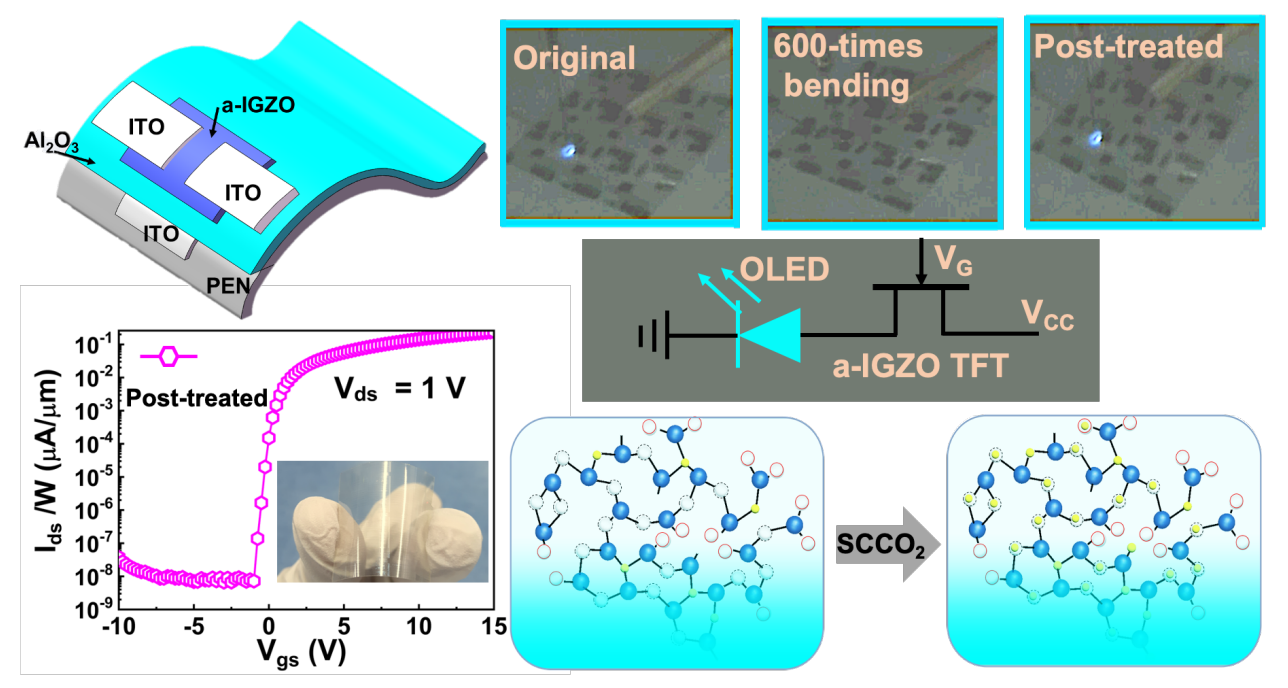Recently, Prof. Zhang Min and Zhang Jiaona, the corresponding author and the first author of our group, respectively, published the research results entitled “performance enhancement and bending restoration for flexible ammonia Indian gallium zinc oxide thin film transistors by low temperature supercritical dehydration treatment” on ACS Applied Materials & interfaces.
For high-performance and high-lifetime flexible and wearable electronic applications, a low-temperature post-treatment method is highly expected to enhance the device performance and repair the defects induced by the low-temperature fabrication process intrinsically. Particularly, if the method can repair the traces induced by the multiple cycles of bending or deforming, it would overcome current fatal obstacles and provide a vital solution to the rapid development of flexible electronics.
In this work, we propose a method to apply low temperature supercritical CO2 fluid with a dehydration function to improve or even restore the performance of flexible amorphous indium gallium zinc oxide (a-IGZO) thin-film transistors (TFTs). CO2 fluid reaching the supercritical phase has the advantage of forceful oxidation capability. With an additive of desiccant calcium chloride (CaCl2), the product H2O inside and outside of devices can be taken away by this treatment method as well. This can passivate oxygen vacancy without hydrolyzing the channel. The TFTs after the post-treatment show excellent electronical characteristics. Analysis based on X-ray photoelectron spectroscopy (XPS), fourier transform infrared spectroscopy (FTIR), reaction models, and capacitance characteristics are used to verify the trap-passivation mechanism. More interestingly, this treatment method can restore the performance of the a-IGZO TFTs even within a system, which is demonstrated by applying the a-IGZO TFTs into an organic light-emitting diode (OLED)-driving system. To date, this is the first work to apply the supercritical fluid treatment to achieve high-performance flexible a-IGZO TFTs and to effectively erase the bending traces in the flexible system. This method has the potential to be used for realizing high-performance, high-lifetime, and larger-scale flexible electronic systems.

By comparison, the post-treated device exhibits a 3-times improvement on the drivability up to 0.24 µA/µm, a larger Ion/Ioff ratio of 3.8×107, a smaller SS of 0.18 V dec-1, a smaller Vth of 0.25 V, and enhanced output characteristics. These are attributed to a higher-quality M-O-M framework, lower amount of H2O molecules in the channel film, and a lower trap density in the interface, as well as a smaller number of oxygen vacancies, and less organic impurities in the oxide layer. Additionally, the a-IGZO TFTs after the SCCO2 and dehydration treatment demonstrate excellent uniformity, reproducibility, flexibility and transparency. Noteworthily, this treatment approach can erase the bending traces and even the device failure by repairing the dangling bonds resulted from multiple bending, as has been verified by applying the treatment to a TFT-driven OLED lighting system. That is, the factor inducing the lighting brightness variation is the TFT performance. Such a low-temperature post-treatment method could be a general solution to improve the performance of flexible electronic devices, which suffer from traps or defects, and to further improve their lifetime so as to save more material in the semiconducting industry. This helps to achieve a more eco-friendly world.